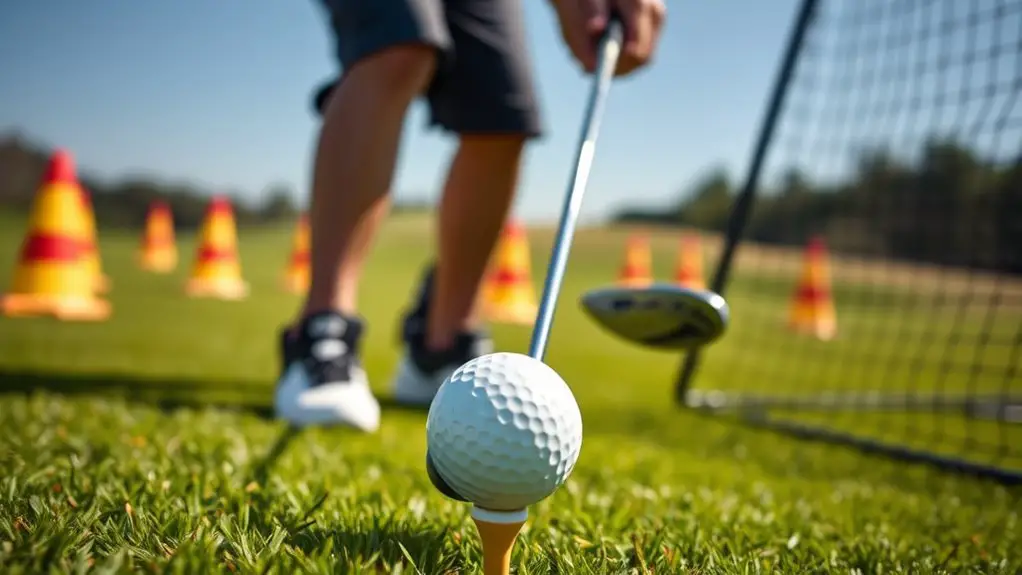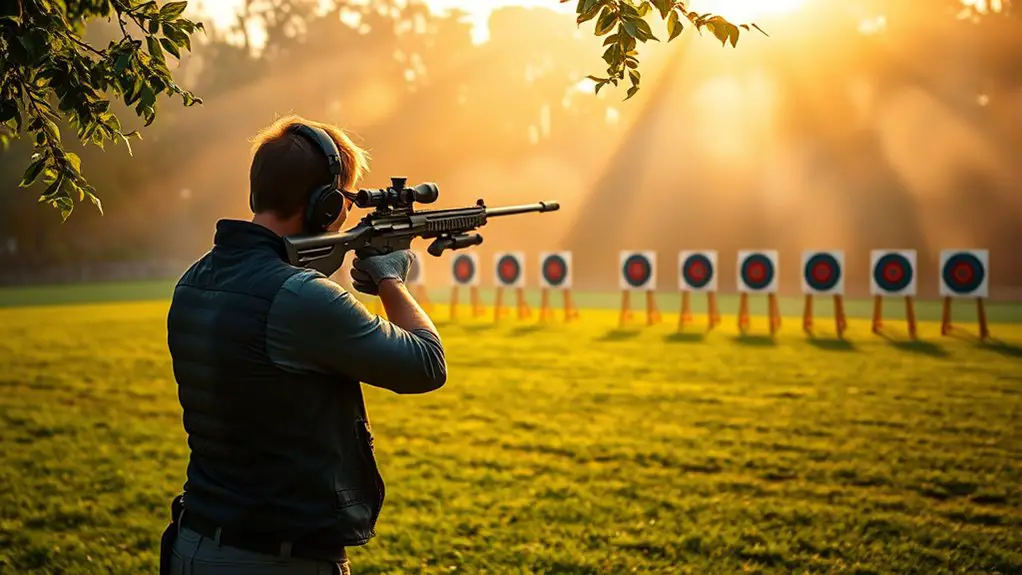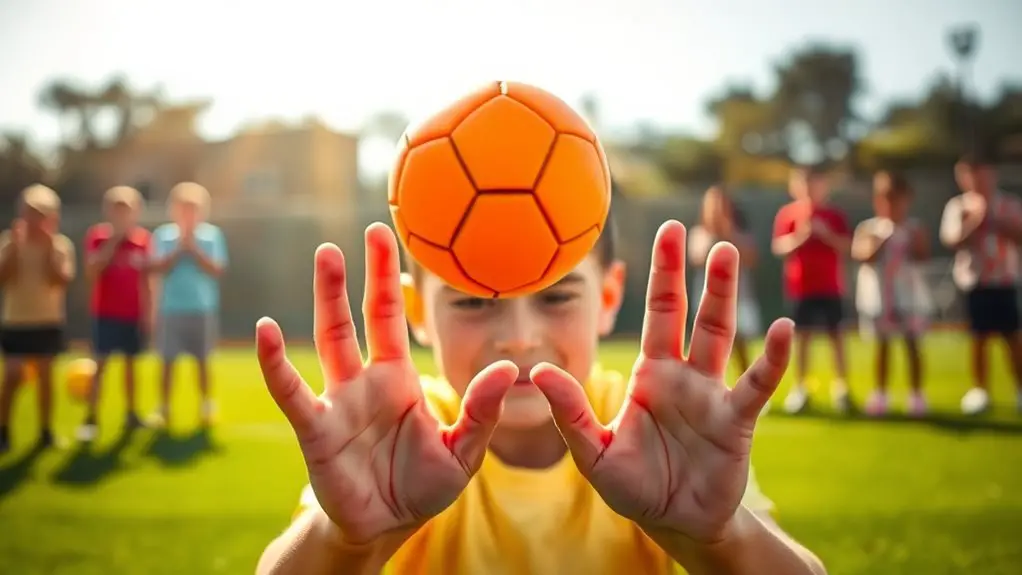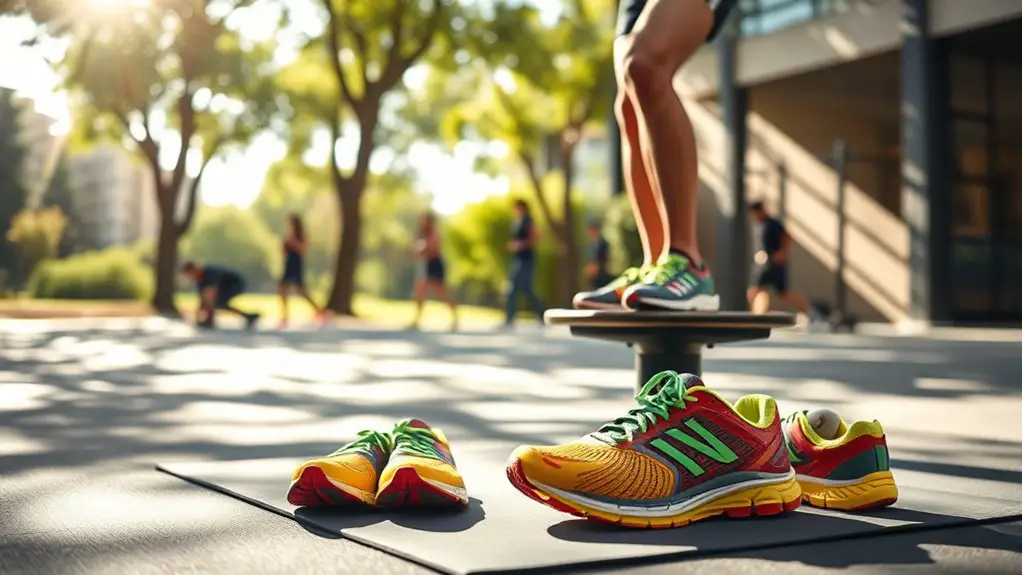Improving your hand-eye coordination in golf is essential for better accuracy and consistency. Start with simple drills like the Ball Toss Drill and the Coin Flip Drill. Partner up for target practice, and try using a foam ball to refine your precision. Swinging with your eyes closed can enhance your instincts, while reaction time exercises will keep you sharp. For a structured approach to measure your progress, keep track of your drills. There's even more effective techniques to explore.
The Importance of Hand-Eye Coordination in Golf
Hand-eye coordination is essential in golf, as it directly impacts your ability to make accurate shots. When you're on the course, feeling that connection between your hands and eyes can elevate your game, revealing the hand-eye benefits that come from refined skills. You want to hit the ball precisely where you aim, and mastering coordination techniques is key to achieving that freedom in your swing.
Improving your hand-eye coordination means you'll experience less frustration and more success, allowing you to enjoy the game even more. It's not just about power; it's about finesse, control, and confidence. When you harness this skill, you're free to express your unique style on the course, making every shot an opportunity to showcase your talent. So, focus on enhancing your coordination, and watch your performance soar while you embrace the joy of golf.
Basic Drills to Start Improving Coordination
To start improving your hand-eye coordination in golf, you can incorporate a few basic drills into your practice routine. Simple swing drills, ball toss techniques, and target practice exercises will help sharpen your skills effectively. Let's explore each of these drills to see how they can benefit your game.
Simple Swing Drills
Improving your hand-eye coordination in golf can start with just a few simple swing drills. Focus on your swing timing by practicing slow, deliberate swings. This helps you feel the rhythm of your motion and connects your body with the club. Use a mirror or video to check your form, ensuring your grip pressure is light yet secure—too tight, and you'll lose fluidity. Try swinging without a ball to concentrate on your mechanics. By refining your timing and grip, you'll develop a smoother swing that enhances your overall coordination. Remember, the goal is to create a natural flow, so let go of tension and enjoy the process. With consistency, you'll see improvement in your game!
Ball Toss Techniques
While you might think of ball toss techniques as simple exercises, they can greatly enhance your coordination on the golf course. Start with basic tosses, throwing a ball straight up and catching it with one hand. As you get comfortable, mix in ball toss variations—like tossing the ball to your opposite hand or adding quick footwork. These coordination challenges not only sharpen your reflexes but also improve your focus. You can even involve a partner for a back-and-forth toss, which adds an element of unpredictability. The more you practice these drills, the more you'll feel in control of your movements, essential for a fluid golf swing. Embrace the freedom of movement, and watch your game flourish!
Target Practice Exercises
Target practice exercises are a fantastic way to sharpen your hand-eye coordination in golf. They empower you to take control of your game while enhancing your focus. Here are three simple drills to get you started:
- Target Selection: Set up targets at varying distances. Aim for different sizes to challenge your accuracy.
- Accuracy Assessment: Use a range of clubs to hit the targets, tracking your success rate. This'll help you gauge improvement over time.
- Dynamic Movement: Incorporate movement by placing targets at different heights or angles. This keeps your practice engaging and adaptable.
The Ball Toss Drill
One effective way to enhance your hand-eye coordination in golf is through the Ball Toss Drill. This simple exercise focuses on ball toss mechanics, allowing you to practice your timing and focus without the pressure of a swing. Start by tossing a tennis ball up in the air with one hand and catching it with the same hand. As you get comfortable, try switching hands or using a golf ball for added challenge.
The ball toss benefits are significant; it sharpens your reflexes and improves your ability to track moving objects, essential skills for a successful golf swing. By incorporating this drill into your routine, you'll notice a boost in your overall coordination, making it easier to connect with the golf ball when it matters most. So, get out there, have fun, and watch your game improve as you master the Ball Toss Drill!
The Coin Flip Drill
To improve your hand-eye coordination in golf, the Coin Flip Drill is an excellent exercise that combines focus and timing. This drill enhances your ability to react quickly and accurately, much like an essential coin toss in a game. Here's how to do it:
Enhance your golf hand-eye coordination with the Coin Flip Drill, focusing on timing and quick reactions.
- Find a coin: Grab a quarter or any coin you have handy.
- Flip and catch: Toss the coin into the air and try to catch it with the same hand.
- Increase difficulty: As you get better, flip the coin higher or use your non-dominant hand.
Target Practice With a Partner
Setting up your practice area with your partner is key to effective target practice. You'll want to choose various target distances to challenge each other and improve your accuracy. Remember to rotate roles regularly to keep the drill engaging and beneficial for both of you.
Setup Your Practice Area
Creating an effective practice area for target practice with a partner can greatly enhance your hand-eye coordination in golf. To set up your space layout, consider these three key elements:
- Designated Area: Choose a flat, spacious spot where you and your partner can safely practice without distractions.
- Practice Equipment: Use cones, nets, or targets to provide clear focal points for your shots, enhancing both fun and focus.
- Distance Markers: Establish different distances to challenge each other and track your improvement over time.
Choose Target Distances
Choosing the right target distances is essential for effective practice with a partner. You'll want to mix up your target selection to keep things fresh and challenging. Start with shorter distances to hone your accuracy, then gradually increase the distance variation as you gain confidence. This approach not only sharpens your hand-eye coordination but also allows you to adapt your swing to different scenarios. Communicate with your partner about which targets to focus on, and take turns aiming at them. This collaborative practice can be more enjoyable and productive, as you'll both learn from each other's strengths. Remember, the key is to keep it fun while pushing your limits!
Rotate Roles Regularly
While practicing hand-eye coordination with a partner, rotating roles regularly can greatly enhance both players' skills. This role reversal in partner drills keeps the experience fresh and engaging. Here's how to make the most of it:
- Switch Targets: Alternate who aims at the target and who observes. This keeps both players focused and sharpens their awareness.
- Adjust Distances: Change the distances or angles from which you hit. This variation challenges both players, improving adaptability.
- Feedback Loop: After each round, provide constructive feedback. Discuss what worked and what didn't, fostering growth in both players.
Using a Foam Ball for Precision
Using a foam ball for precision can greatly enhance your hand-eye coordination in golf. This simple yet effective tool offers several foam ball benefits that can elevate your training. By focusing on precision training with a foam ball, you can develop better control and accuracy in your swings.
Here's a quick comparison of foam ball benefits:
| Benefit | Description |
|---|---|
| Lightweight | Easy to handle, reducing fatigue during drills |
| Safe Practice | Minimizes risk of injury or damage to surroundings |
| Versatile Usage | Can be used for various drills and exercises |
Incorporating foam balls into your practice routine allows you to focus on your swing mechanics without the pressure of using real golf balls. You'll find that this approach not only sharpens your skills but also adds an element of fun to your training sessions. Enjoy the freedom to experiment and improve!
Swinging With Eyes Closed
Swinging with your eyes closed can be a game-changer for your hand-eye coordination in golf, as it forces you to rely on your body's natural instincts and muscle memory. By shutting your eyes, you enhance your swing mechanics and sharpen your mental focus, creating a deeper connection with your body's movements. Practicing mindfulness and relaxation techniques during this drill can further help calm your mind and improve your performance.
Here are three steps to maximize this drill:
- Warm Up: Start with a few swings with your eyes open to establish a baseline feel for your swing mechanics.
- Close Your Eyes: Take a few practice swings with your eyes closed, focusing solely on your body's rhythm and muscle memory.
- Gradually Increase Power: As you gain confidence, increase your swing speed while maintaining control and balance.
This exercise helps you trust your instincts and enhances your overall performance on the course. Embrace the freedom of this drill and watch your coordination improve!
Incorporating Reaction Time Exercises
After honing your muscle memory with eyes-closed swings, it's time to incorporate reaction time exercises into your training routine. These drills will sharpen your cognitive processing, allowing you to respond quicker on the course. One effective method is to use a reaction ball, which bounces unpredictably. As it rebounds, your goal is to catch it, forcing your brain and body to react swiftly.
Another great drill is to practice with a partner who randomly tosses a ball at you while you maintain your stance. This keeps your focus sharp and improves your hand-eye coordination under pressure. You can also try hitting a moving target, like a golf ball on a tee, while someone else swings a club nearby. Additionally, incorporating visualization techniques can help mentally prepare you for instinctive reactions during your game.
Tracking Progress and Adjusting Drills
As you progress through your hand-eye coordination drills, it's crucial to track your improvements and adjust your practice accordingly. This guarantees you're not just going through the motions but truly enhancing your skills. Here are three key ways to incorporate progress tracking and drill adjustments:
- Keep a Journal: Document your daily practice sessions, noting what drills you performed and any improvements you noticed. This helps identify patterns in your progress.
- Set Benchmarks: Establish specific goals for each drill. For instance, aim to successfully complete a drill four times in a row before moving on to a more challenging variation.
- Seek Feedback: Don't hesitate to ask a coach or a fellow golfer for their perspective on your performance. External insights can highlight areas for improvement you might overlook.
Frequently Asked Questions
How Long Should I Practice These Drills Each Day?
When it comes to daily practice, the ideal duration really depends on your schedule and goals. Aim for about 20 to 30 minutes each day; this gives you enough time to focus without feeling overwhelmed. Remember, consistency is key, so find a rhythm that fits your lifestyle. You don't need to push yourself too hard—just enjoy the process and watch your skills improve over time.
Can I Improve Hand-Eye Coordination Without a Golf Club?
Absolutely, you can improve your hand-eye coordination without a golf club! Engaging in activities that enhance visual tracking and reaction time can be incredibly beneficial. Try juggling, playing catch, or even video games that require quick reflexes. These activities help train your brain and body to work together, giving you the freedom to explore different skills. So, go ahead and mix things up; you'll see progress in your coordination in no time!
What Age Is Ideal to Start Training Hand-Eye Coordination?
Picture a child, darting through a park, laughter echoing, while another struggles with a simple catch. The ideal age to start training hand-eye coordination is around two to three, when many coordination milestones emerge. This early stage of child development allows them to embrace movement and play, fostering natural skills. By nurturing these abilities now, you're not just freeing their mind, but also giving them the tools to explore their world with confidence.
Are There Specific Exercises for Left-Handed Golfers?
If you're a left-handed golfer, there are specific left-handed drills that can enhance your skills. Try practicing with coordination techniques like hitting targets with a tennis ball or using a mirror to refine your swing. You can also incorporate resistance bands to build strength and control. Embrace these exercises to release your potential, and don't hesitate to experiment with different drills that feel right for you. Freedom in your practice leads to improvement!
How Do I Know if I'm Improving My Coordination?
You know how in the old days, folks used to track their progress with a trusty notebook? Well, you can do something similar with your coordination! To assess your coordination, keep a log of your practice sessions and note improvements in accuracy and speed. Progress tracking can help you see patterns over time. Don't forget to challenge yourself occasionally; if things start feeling too easy, it might be time to level up those drills!




